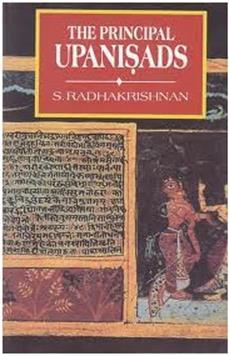Textual Corruption of the Vedas
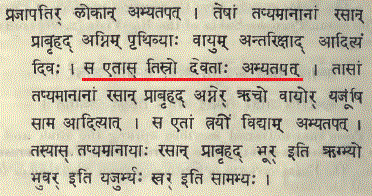
Written by Ibn Muhammad
Make sure that you read the article ‘Origin of Vedas, Their Inspiration and Authority‘ to have a better comprehension of this article.
After reading about the origin of Vedas, we now move on to the textual corruption of the Vedas. A lot of claims are made by many modern Hindus about the perfect preservation of the Vedas. Mr. Agniveer too makes such high flying claims. I have analyzed this topic objectively and want to present the result before the readers.
Let me start by sharing with you an interesting yet ludicrous story that is mentioned in the Shanti Parv of Mahabharata; the story of the Vedas being stolen from the Creator of the Worlds by two demons, Madhu and Kaitabha. We read about this in Shanti Parv, Section 348. The two mighty Danavas (demons), having seized the Vedas, quickly dived into the ocean of waters which they saw and proceeded to its bottom. Seeing the Vedas forcibly taken away from him, Brahma Ji became filled with grief, and started wailing. The Vedas were later recovered by Vishu Ji’s timely intervention but still it shows the insecurity of the Vedic texts from the very beginning. If Brahma Ji had memorized the Vedas, how could the Vedas have been stolen? Perhaps his memory was not that strong after all. I only shared this story to give the readers an idea of a book which according to Mr. Agniveer is the ‘greatest wonder of human civilization’. Truly a wonder it is.
What is the total number of the Vedas?
Three, Four or Five Vedas?
One opinion is that there are three deiies, and from them originate the three Vedas or three types of mantras.

“1. Prajapati brooded over the worlds, and from them thus brooded on he squeezed out the essences, Agni (fire) from the earth, Vayu (air) from the sky, Aditya (the sun) from heaven.
2. He brooded over these three deities, and from them thus brooded on he squeezed out the essences, the Rik verses from Agni, the Yagus verses from Vayu, the Saman verses from Aditya.” [Chandogya Upanishad- Adhyay 4, Khanda 17, Mantras1 and 2]
The same view is expressed in Shatpath Brahman 11:5:8:1,2. Note only three Vedas are spoken here. Further Manu 1:23 says,
“But from fire, wind, and the sun he drew forth the threefold eternal Veda, called Rik, Yagus, and Saman, for the due performance of the sacrifice.”
Also see Manu 2:118, 2:118, 2:230, 9:188, where only three Vedas have been mentioned.
Even Swami Dayanand writes in Satyarth Prakash, Chapter 3, on the authority of Manu Smriti 3:1,
“Thus after joining the school at the age of 8 years, if a student studies the Vedas with their subsidiary subjects for 36 years, (i.e., he devotes 12 years to the study of each of the three Vedas), he completes his education at the age of 36+8=44.”
Therefore, according to Swamiji and Manu Smriti, Vedas are only 3. Is Atharvaved really a genuine Veda?
The popular opinion is that Vedas are four in number viz. Rigved, Yajurved, Samved and Atharvaved. Another opinion is that Vedas are five in number because Atharvaved is actually two Vedas; one is Atharvaved and the other Angirasved.
The divergent opinions regarding the number of Vedas do not end here. Another authoritative view which holds its place is that Vedas number 1131 as we shall see.
1131 Vedas?
According to the Mahabhasya of Patanjali, there were 21 Shakhas of Rigveda, 9 of Atharvaveda, 101 of Yajurveda (86 of Krishna Yajurveda and 15 of Shukla Yajurveda, according to later authorities) and a 1000 shakhas of Samaveda. All these add to give the figure 1131. All these Shakhas are considered to be Vedas. The words Shakha means a ‘branch’ or a ‘limb’ and refers to a particular traditional text followed, as in the phrase śākhām adhite, (“he recites a particular version of the Veda”).
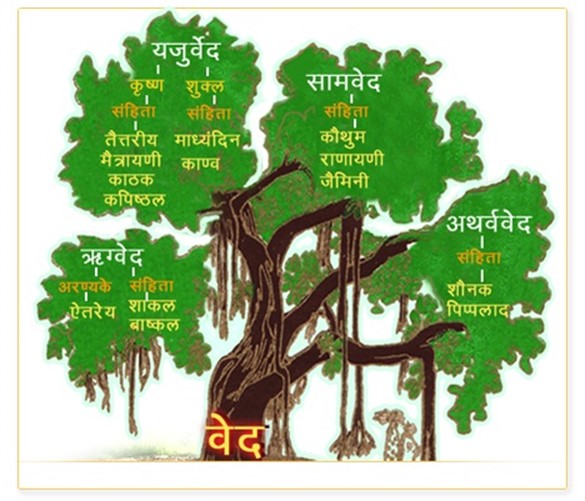
However, out of these 1131 Shakhas, only 11 Shakhas remain alive. As far as Rigved is concerned, only one Shakha, Shaakal Shakha alone remains alive out of the 21 that existed at one time. Another shakha that may have survived is the Bāṣhkala, although this is uncertain. Out of the 101 Shakhas of Yajurveda, only 6 are alive. In fact, Yajurveda is classified broadly into Shukla Yajurveda (White) and Krishna Yajurveda (Black). The former is popular in North India while the later is popular in South India. Shukla Yajurveda is also known as Vajasaneyi. The Vajasaneyi Samhita has forty chapters or adhyayas and there are two extant Shakhas of Shukla Yajurveda viz. Kanvaand Madhyandina. Krishna Yajurveda has 4 extant Shakhas viz.
- Taittirīya
- Maitrayani
- Kaṭhak
- Kapiṣṭhala
There are three surviving Shakhas out of 1000 of the text of the Samaveda Samhita:
- the Kauthuma Shakha is current in Gujarat, Uttar Pradesh, Orissa and since a few decades in Darbhanga, Bihar,
- the Jaiminiya in the Carnatic, Tamilnadu and Kerala,
- and the Rāṇāyanīya in the Maharastra.
Out of the nine Shakhas of Atharvaveda, only two have survived
- Paippalāda, in regions south to Narmada river
- Shaunakīya, in regions north to Narmada river
What we know today as Rigveda, Yajurveda, Samaveda and Atharvaveda are actually Shakhas from the multitude of other Shakhas. The so called Vedas are never named as Vedas in their hymns. In other words, Rigveda is never called Rigveda in the Rigveda itself. If it be said that in other scriptures they have been called as Vedas, we can respond that so many other things have been called as Vedas also. For example, Ayurveda (Medicine), Sarpaveda (snakes), Dhanurved (weapons), Itihasaveda (History), Puranaveda (Stories). These words are based on Shatapath Brahman 13:4:3.
Hence, 1121 versions of Vedas have been lost. If someone will say that the Shakhas are not Vedas but only the explanations/commentaries that would be erroneous. The presently known Vedas are also Shakhas. So are these commentaries or actual Vedas? To say that Shakhas are not the Vedas will be to undermine the present Vedas (read Shakhas) also. Considering the two opposing Shakhas of Yajurveda we may ask, “Is Madhyandina Shakha (Shukla Yajurveda) the original or Taittirīya Shakha (Krishna Yajurveda)?”.
The above analysis makes it clear that a large portion of the Vedas has been lost.
A topical study of the corruption of the Vedic text
Missing Verses
After the collection and codification of Vedas, many different manuscripts gained currency amongst the Brahmin groups. The number of mantras in every manuscript continued to be changed. The current version of Rigveda was collected by Shaakal Rishi and was thus called Shaakal Samhita. It is divided into 10 Mandals (Books).
Nirukt 7:8 mentions the following,
“There is a joint oblation offered to Agni and Vishnu in the ten books of the Rigveda.”
However, in the entire Rigveda, there is not a single mantra jointly praising Agni and Vishnu. What is meant by joint oblation here? An oblation is an offering (Late Latin oblatio, from offerre, oblatum, to offer), a term, particularly in ecclesiastical usage, for a solemn offering or presentation to God. Where is an offering jointly made to Agni and Vishnu, we would like to see? This is a clear evidence that the Rigveda at the time of Yaska Muni had the joint oblation offered to Agni and Vishnu, but it is not found in today’s Rigveda, demonstrating corruption of the text.
Corruption in recitation
The oral tradition of the Vedas (Śrauta) consists of several pathas, “recitations” or ways of chanting the Vedic mantras.The padapatha consists of dividing the sentence into individual pada or words. The kramapatha consists of pairing two words at a time. There has been a lot of corruption in the former recitation. I will give some examples to demonstrate this.
Example 1
Yask Muni, the author of Nirukt and Nighantu, writes that Vaayah is one word [See Nirukt 6:28]. But in the Shaakal Shakha’s (Rigveda’s) padapatha, it has been divided and hence became meaningless. Rigveda 10:29:1 is the place which has made the mistake.

“As sits the young bird on the tree rejoicing, ye, swift Pair, have been roused by clear laudation,…”
Yaska himself criticizes Shakalya and says,
“Sakalya has analyzed Vaayah into Vaa and yah, then the finite verb would have had the accute accent and the sense have been incomplete.”
Example 2
Rigveda 5:39:1 goes as follows,

“O Indra, wielder of the thunderbolt, give us whatever excellent treasure there is. With both hands bring that wealth to us, O treasure-knower”
Yaska says on this,
“Sakalya the author of Rigveda padapatha, does not analyze the word Mehanaa, while Gargya the author of Samaveda padapatha analyzes it into Me-iha-naa.” [Nirukt 4:4]
Let us see what Samaveda, Book 4; Chapter 2; Decade 1; Mantra 4 does,

Now there is a world of difference between Mehanaasti and Me-iha-naasti. The former means ‘I have wealth’ and the latter means ‘I do not have’.
Different versions of Rigveda
Shaakal Rishi is called as the collector of Rigveda. He had a number of students, who later expressed many differences and compiled their own versions of Rigveda. numbering upto 21. There are major differences between the Shaakal and Baskal samhitas of Rigveda. The Śākala recension has 1,017 regular hymns, while the Bāṣkala samhita has a total of 1025 hymns. Thus, around some 50 mantras are missing in Śākala samhita. There are differences even over the total number of mantras.
- According to Anuvakanukramani Rigveda has 10,580 mantras
- According to Gayatri Parivar Rigveda has 10,552 mantras
- According to Sayanacharya it has 10,000 mantras
- According to Swami Dayanand Saraswati it has 10,589 mantras
As per these figures, some 500 mantras are doubtful or interpolated. However, the story does not end here. Pandit Ram Govind Trivedi, mentions another surprising fact in the preface to his Hindi translation of the Rigveda. He says,

“According to one Mantra of Rigveda (Page 1403, Mantra 8), we come to know that it has 15,000 Mantras. However, when we count the total Mantras, we get 10,469 Mantras. It is possible that like a large portion of the books of Vedic literature and Vedas were destroyed by the anti-religious, similarly, Mantras too suffered destruction for many reasons.”
The Mantra he is talking about is Rigveda 10:114:8, which says,

GAYATRI PARIVAR TRANSLATION

According to this analysis, Vedas have easily lost about 4,500 Mantras.
Different versions of Yajurveda
As I said earlier, out of 101 Shaakhas of Yajurveda only 6 are extant. There are two principal texts of the Yajur-Yeda, called respectively the White and the Black, or the Vajasaneyi and Taittiriya Samhitas.
The Vishnu Purana gives the following explanation of their names : Vaisampayana, a pupil of the great Vyasa, was the original teacher of the Black Yajur-Veda. Yajnavalkya, one of his disciples, having displeased him, was called upon by his master to part with the knowledge which he had acquired from him. He forthwith vomited the Yajur-Yeda. The other disciples of Vaisampayana, assuming the form of partridges (tittiri), picked up from the ground its several dirtied texts. From this circumstance it received the name of Taittiriya Krishna Yajur-Veda. A more rational explanation is that Vaisampayana taught it to Yaska, who taught it to Tittiri, who also became a teacher. Yajnavalkya afterwards, by the performance of severe penances, induced the Sun to impart to him those Yajur texts which his master had not possessed. The Sun then assumed the form of a horse (Vajin), and communicated to him the desired texts. Hence the Sanhita was called Vajasaneyi, and also White (or bright) because it was revealed by the Sun.
- There are a lot of differences between the two versions. The first mantra of both is same despite some difference in the wording. The arrangement and wording of White Yajurveda upto Adhyay 15 is radically different from the Black Yajurveda. The mantras of the 39th Chapter of Shukla Yajurveda are not found in Krishna Yajurveda.
- An amazing information about Shukla Yajurveda is that the last chapter (Chapter 40) is actually an Upanishad, the Ish Upanishad. As per the belief of Arya Samaj, Upanishads are not revealed scriptures. It is worth noting that while it is counted with the Upanishads, the Ish Upanishad remains non-revealed and when it is added to the Veda it become revealed.
- The Ish Upanishad is not the only addition to this Yajurveda. A lot of Brahamanas have been inserted into the text of the Yajurveda. For example, Adhyay 24 is entirely a Brahman; Adhyay 30: verses 7 through 15 are all Brahmanas and not Mantras.
Not only in the ancient period, but in recent times too there have been many changes in the Vedic texts by Swami Dayanand Saraswati and his followers.
Following is a list of changes that have been made.
- In the Yajurveda Bhasya of Dayanand Ji, Adhyay 9, Mantra 20 has been distorted by adding the word Gamyaat, which is not to be found in the text. Where did this word come from?
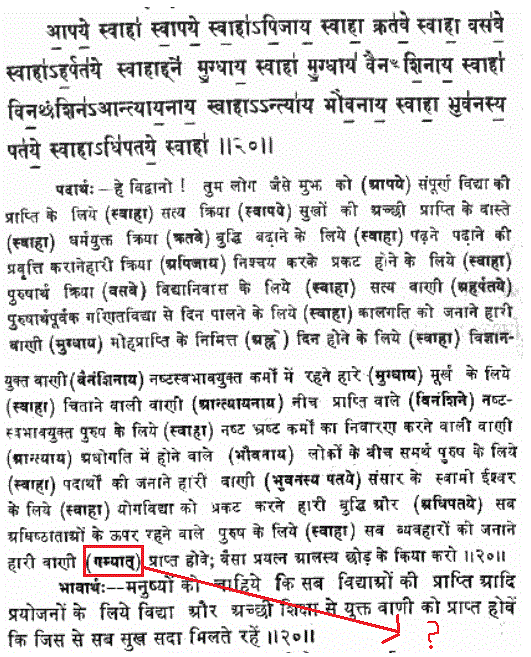
- Comparing the Yajurveda of Gayatri Parivar and Arya Samaj, there are many mantras missing in one or another of the versions. For example, the 25th Chapter of Gayatri Parivar Yajurveda has 47 mantras. Even the Yajurveda of Ralph Griffith has 47 mantras. But, the Arya Samaj version has an additional Mantra 48.
SEE THE GAYATRI PARIVAR/SANATAN DHARMI VERSION BELOW
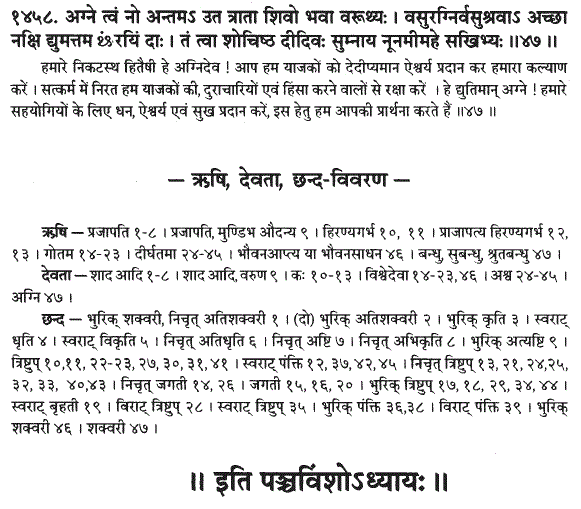
SEE THE ARYA SAMAJ VERSION BELOW
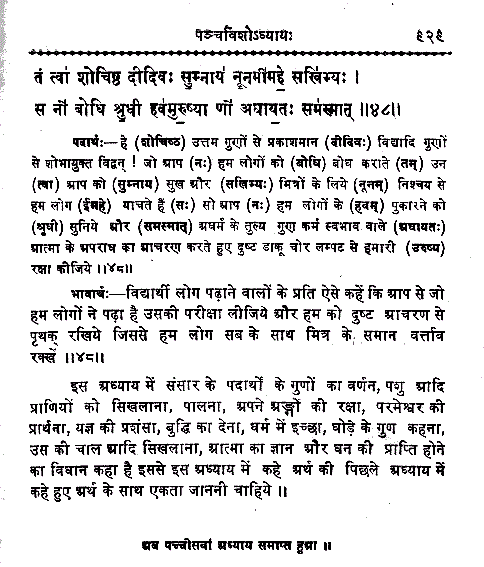
- In Yajurveda Bhashya of Dayanand Ji Adhyay 26, mantra 26, the word Ayohtay was changed to Apohtay
SEE THE GAYATRI PARIVAR VERSION BELOW
![]()
SEE THE ARYA SAMAJ VERSION BELOW

- In Yajurveda Bhashya of Dayanand Ji Adhyay 39, mantra 5, the word Vishyandmaane was changed to Vishpandmaane
SEE THE GAYATRI PARIVAR VERSION BELOW

SEE THE ARYA SAMAJ VERSION BELOW
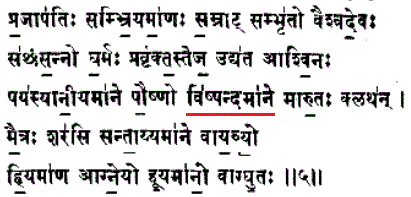
- The longer ending in Yajurveda 13:58 has been deleted from Arya Samaj version, but exists in the Gayatri Parivar version.
SEE THE GAYATRI PARIVAR VERSION BELOW

SEE THE ARYA SAMAJ VERSION BELOW

No one can call these interpolations and alterations to be printing errors, because the translations also have been made of the interpolations. These are examples of deliberate interpolations.
Corruption of Samaveda
Samaveda is heavily borrowed from the Rigveda. It consists of a collection of hymns, portions of hymns, and detached verses, all but 75 taken from the Sakala Sakha of the Rigveda, the other 75 belong to the Bashkala Sakha, to be sung, using specifically indicated melodies, called Samagana. There are differences regarding the exact number of mantras in the Samaveda. As I said earlier, according to Patanjali’s statement, “sahasravartma samvedah” सहस्रवर्त्म
समवेदः, “There are thousand branches of Samaveda”. However, only three survive:
- the Kauthuma Shakha is current in Gujarat, Uttar Pradesh, Orissa and since a few decades in Darbhanga, Bihar,
- the Jaiminiya in the Karnatak, Tamilnadu and Kerala,
- and the Rāṇāyanīya in the Maharastra.
The total mantras in the Jaimniya Shakha is 1687. Kauthama Shakha has 1869 mantras . Thus, 182 mantras are missing fromKauthama Shakha. An analysis of both these versions reveals lots of Paath-Bhed (variant readings). Besides this, there is a difference in number of songs attributed to different branches. Shri Satvalekar in his preface to Samaveda Samhita has given the following table of songs (Samagana).
| Songs of Jaiminiya Branch | Songs of Kauthamiya Branch | |
| Gramgeyo-gān: | 1233 | 1197 |
| Aranyageya-gān: | 291 | 294 |
| Ooh-gān: | 1802 | 1026 |
| Oohya-gān: | 356 | 205 |
| Total | 3681 | 2722 |
We can easily see that the Samaganas of Jaiminiya Version are 1000 more than those of Kauthamiya Version.
Corruption in Atharvaveda
Atharvaveda, also known as Brahmaveda is considered the youngest amongst all other Vedas. As I mentioned earlier, out of the nine versions of Atharvaveda according to Patanjali, only two are extant
- Paippalāda, in regions south to Narmada river
- Shaunakīya, in regions north to Narmada river
Both versions have lot of differences in the words and arrangement. Paippalada Shaakha can further be divided into two parts; Atharvaveda and Angirasveda. It is mentioned in Shatapath Brahman 13:4:3:4-8 in the context of the Ashvamedha sacrifice; after theYagya (ritual) is completed, the householders should be instructed in Rigveda of the first day. old men should be instructed in Yajurveda on the second day, handsome youths should be instructed in Atharvaveda on the third day and handsome maiden should be instructed in Angirasveda on the fourth day. Angirasveda is attributed to Rishi Angiras who is in the fourth generation after Rishi Atharva. There is no mention of Samaveda in this reference of Shatapath Brahman.
Patanjali Rishi, in his Mahabhasya, has given the first mantras of all the four Vedas. In the present Atharvaved (Shaunak Shaakha) it is not the first mantra, but the 26th mantra. This means 25 mantras are extra in that Shaunak shaakha.
Following is an exmaple of textual corruption in the Atharvaveda.
Atharvaveda Khand 20 and Sookt 127 is part of the Kuntap Sooktas. In the third mantra of this Sookt there has been an alteration. The Atharvaveda of Arya Samaj and Gayatri Parivar both have it as follows:

The word preceeding Maamahe is Eeshaai. However, in the Atharvaveda of Pandit Raja Ram Shashtri of Arya Samaj as well as the Atharvaveda printed in Germany, the text differs as follows:

Here the word preceeding Maamahe is Rishye and not Eeshaai. This makes a difference in the meaning of the mantra.
Conclusion
The above analysis proves beyond the shadow of a doubt that Vedas have suffered heavy interpolations and changes. Talking strictly, even if one accusation of the above analysis stands, the entire Vedic literature will be unacceptable as a genuine inspired document.
